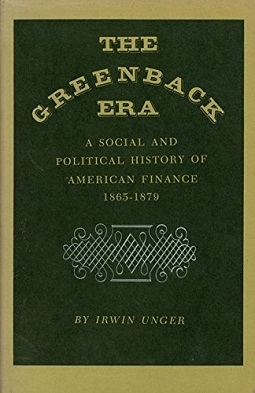The Greenback Era: A Social and Political History of American Finance, 1865-1879 by Irwin Unger

CHAPTER I
THE ROOTS OF CONFLICT
I
THE problems of Reconstruction finance were sown in the
thirteen feverish months following Lincoln's election. The acute
political crisis, the unprecedented drain on the country's human
and economic resources, the releasing of restraints as the po-
litical and military shock jarred men loose from customary prac-
tices—all combined to raise up a host of new financial prob-
lems that would trouble America for a generation.
Secession not only rocked the country to its political foun-
dations; it also set off a short but acute business slump which,
joined with the loss of the South, cut deep into federal revenues.
Still shaky from the effects of the 1857 panic, the Treasury was
soon in desperate straits, unable to meet its current demands
and forced to pay as much as 12 per cent to keep the govern-
ment in funds.
This was the critical situation when the new Secretary of the
Treasury, Salmon P. Chase, took up his duties in March 1861.
In August the Treasury negotiated the first war loan with an
association of New York, Philadelphia, and Boston banks and
set in motion the forces of postwar financial strife. Under the
agreement concluded, the banks were to take $50 million of 7.3
per cent Treasury notes, to be followed, at the bankers' option,
by two additional $50 million lots later in the year. Contrary
to the bankers' advice, Chase, a rather primitive bullionist
Democrat, expected an immediate payment in gold delivered
to the Sub-treasury door. Complying with his terms was a
serious drain on the banks' reserves, offset only by resales of
securities to the public and rapid government spending, which
soon returned the gold to the banks' vaults. Although still uneasy,
the banks took their second installment in October and the third
in mid-November. Then disaster. The Trent Affair and the threat
of war with England, the controversial removal of Fremont
from command of the Western Department, Grant's failure be-
fore Belmont, and, finally, Chase's Annual Report which re-
vealed the probability of a large Treasury deficit, shook public
confidence, stopping resales and sending gold into hiding. Specie
reserves quickly fell to dangerous levels. Between December
7 and 28 the New York banks alone lost almost $13 million of
their gold. Two days later banks all over the country, im-
mediately followed by the Treasury, ceased paying coin for
their obligations. The nation had left the gold standard.
Specie suspension was to create one of the most urgent fi-
nancial questions of the postwar years, but three areas of war-
time financial legislation gave rise to equally troublesome prob-
lems. The most important of these was the emission of legal
tender paper money early in 1862 to help pay for what was fast
The Greenback Era: A Social and Political History of American Finance, 1865-1879 by Irwin Unger




